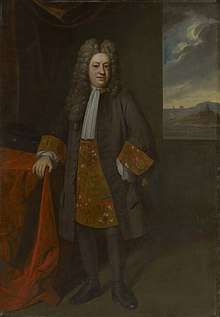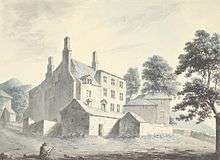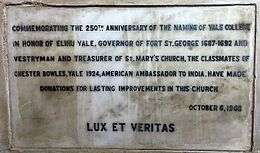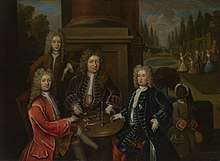Elihu Yale
Elihu Yale (5 April 1649 – 8 July 1721) was a British-American merchant. He was president of the East India Company settlement in Fort St. George, at Madras, where he benefitted from the slave trade. Yale was a benefactor of the Collegiate School in the Colony of Connecticut, which, in 1718, was renamed Yale College in his honor.[1]
Elihu Yale | |
|---|---|
 | |
| President of Fort St. George | |
| In office 25 July 1687 – 3 October 1692 | |
| Preceded by | William Gyfford |
| Succeeded by | Nathaniel Higginson |
| In office 8 August 1684 – 26 January 1685 | |
| Preceded by | William Gyfford (Agent) |
| Succeeded by | William Gyfford |
| Personal details | |
| Born | 5 April 1649 Boston, Colony of Massachusetts, British America |
| Died | 8 July 1721 (aged 72) London, England |
| Signature | |
Life

Born in Boston, Massachusetts, to David Yale (1613–1690) and Ursula Knight, he was the grandson of Ann Lloyd (1591–1659), who after the death of her first husband, Thomas Yale (1587–1619) in Chester, Cheshire, England, married Governor Theophilus Eaton (1590–1658) of New Haven Colony.
The Yale family left Boston and returned to England when Elihu was three years old and he grew up and went to school in London.
For 20 years Yale served the Honourable East India Company. In 1684 he became the first president of Fort St. George, the company's post at Madras (now Chennai), India. He succeeded a number of agents from Andrew Cogan to William Gyfford. Yale was instrumental in the development of the Government General Hospital, housed at Fort St. George.[2]
Yale amassed a fortune while working for the company, largely through secret contracts with Madras merchants, against the East India Company's directive. By 1692, his repeated flouting of East India Company regulations and growing embarrassment at his illegal profiteering resulted in his being relieved of the post of governor.[3]

Yale returned to Britain in 1699. He spent the rest of his life at Plas Grono in Wales, a mansion bought by his father, or at his house in London, spending liberally the considerable wealth he had accumulated.[4]
Yale's ancestry can be traced back to the family estate at Plas yn Iâl near the village of Llandegla in Wales.[4]
Tenure as President of Madras

Elihu Yale was re-appointed as president of the administration of Fort St George on 26 July 1687. He then implemented an order dated 14 January 1685 which required the English at Fort St George to make all attempts at procurement of the town of St Thome on lease. To this effect, Chinna Venkatadri was sent to negotiate with the local governor on 4 August 1687. The mission was successful and Chinna Venkatadri assumed sovereignty over St Thome for a period of three years. Notwithstanding the vehement protests of the Portuguese inhabitants of St Thome, the English gained absolute control over all lands up to St Thomas Mount for a period of three years.
In September 1688, the Mughal Emperor Aurangazeb took Golconda after a prolonged battle. The Mughals took Sultan of Golconda prisoner and annexed the state. The newly designated Mughal Subedar of the province immediately sent a letter to the British authorities at Fort St George demanding that the English at Madras acknowledge the overlordship of the Mughal Emperor. The English complied willingly. Aurangazeb guaranteed the independence of Madras, but in return demanded that the English supply troops in the event of a war against the Marathas. It was around this time that Yale's three-year-old son David Yale died and was interred in the Madras cemetery.
The records of this period mention a flourishing slave trade in Madras. After English merchants began to kidnap young children and deport them to distant parts of the world, the administration of Fort St George stepped in and introduced laws to curb the practice. On February 2, 1688, Elihu Yale decreed that henceforth, slaves should be examined by the judges of the choultry before being transported. Transportation of young children, in particular, was made unlawful.[5] Beyond this, the nature of Yale's involvement in the slave trade remains disputed. A blog post by a Yale graduate student suggests that he permitted a law that at least ten slaves should be carried on every ship bound for Europe, and notes that in his capacity as judge he also on several occasions sentenced so-called "black criminals" to whipping and enslavement.[6] On the other hand, according to Steven Pincus, a former Yale professor of history and current professor at the University of Chicago, Yale was never a slave trader and never owned slaves — and in fact opposed the slave trade during his time as governor of Madras.[7]
During Yale's presidency, a plan for setting up a corporation in Madras was conceived by Josiah Child, the Governor of the East India Company, in a letter addressed to the factors at Madras on 28 September 1687. Three months later, Josiah Child and his deputy had an audience with James II, and as per the ensuing discussions, a Charter was issued by the king on 30 December 1687 which established the Corporation of Madras. The charter came into effect on 29 September 1688, and a Corporation was established comprising a Mayor, 12 Aldermen, 60-100 Burgesses and sergeants. Nathaniel Higginson, who was then the second member of the Council of Fort St George took office as the Mayor of Madras.
In August 1689, a French fleet appeared near the coast of Ceylon compelling the Governor of Pulicat Lawrence Pitt who was on high seas to seek protection within the bastions of Fort St George. Throughout the year 1690, French naval ships from Pondicherry ravaged the coast in order to drive the English and the Dutch out of the East Indies but were unsuccessful. They eventually withdrew from their enterprise when faced with heavy losses. It was also during this time that the English purchased the town of Tegnapatnam from the Marathas.
Marriage
Yale married Catherine Hynmers, a widow, in 1680. The wedding took place at St. Mary's Church, at Fort St. George, where Yale was a vestryman and treasurer. The marriage was the first registered at the church.[8]
Scandal
After Jacques de Paiva's[9] death in 1687, Elihu Yale fell in love with his widow Hieronima de Paiva and brought her to live with him, causing quite a scandal within Madras’ colonial society. Elihu Yale and Hieromima de Paiva had a son. The son died in South Africa.[9]
Accusations of corruption and removal
As president of Fort St. George, Yale purchased territory for private purposes with East India Company funds, including a fort at Devanampattinam (now Cuddalore). Yale imposed high taxes for the maintenance of the colonial garrison and town, resulting in an unpopular regime and several revolts by Indians, brutally quelled by garrison soldiers. Yale was also notorious for arresting and trying Indians on his own private authority, including the hanging of a stable boy who had absconded with a Company horse.[3]
Charges of corruption were brought against Elihu Yale in the last years of his Presidency. He was eventually removed in 1692 and replaced with Nathaniel Higginson as the President of Madras.
Death

Yale died on 8 July 1721 in London, but was buried in the churchyard of the parish church of St. Giles.[10] His tomb is inscribed with these lines:
Born in America, in Europe bred
In Africa travell'd and in Asia wed
Where long he liv'd and thriv'd; In London dead
Much good, some ill, he did; so hope all's even
And that his soul thro' mercy's gone to Heaven
You that survive and read this tale, take care
For this most certain exit to prepare
Where blest in peace, the actions of the just
Smell sweet and blossom in the silent dust.
In Boston, Massachusetts, a tablet to Yale was erected in 1927 at Scollay Square, near the site of Yale's birth. Yale president Arthur Twining Hadley penned the inscription, which reads: "On Pemberton Hill, 255 Feet North of This Spot, Was Born on April Fifth 1649 Elihu Yale, Governor of Madras, Whose Permanent Memorial in His Native Land is the College That Bears His Name."[11]
Yale University
In 1718, Cotton Mather contacted Yale and asked for his help. Mather represented a small institution of learning that had been founded in 1701 in Old Saybrook, Connecticut, as the Collegiate School of Connecticut, which needed money for a new building. Yale sent Mather 417 books, a portrait of King George I, and nine bales of goods. These last were sold by the school for £800 pound sterling.[12] In gratitude, officials named the new building Yale; eventually the entire institution became Yale College.[1]
Yale was also a vestryman and treasurer of St. Mary's Church at Fort St. George. On 6 October 1968, the 250th anniversary of the naming of Yale College for Elihu Yale, the classmates of Chester Bowles, then the American ambassador to India and a graduate of Yale (1924), donated money for lasting improvements to the church and erected a plaque to commemorate the occasion. In 1970 a portrait of him, Elihu Yale seated at table with the Second Duke of Devonshire and Lord James Cavendish was donated to the Yale Center for British Art from Chatsworth House.
On 5 April 1999, Yale University recognized the 350th anniversary of Yale's birthday.[1] An article that year in American Heritage magazine rated Elihu Yale the "most overrated philanthropist" in American history, arguing that the college that became Yale University was successful largely because of the generosity of a man named Jeremiah Dummer, but that the trustees of the school did not want it known by the name "Dummer College".[13]
In her article for The Atlantic about Skull and Bones, a secret society at Yale University, Alexandra Robbins alleges that Yale's headstone was stolen years ago from its proper setting in Wrexham. She further alleges that the tombstone is now displayed in a glass case in a room with purple walls.[14]
#CancelYale Movement

The #CancelYale movement demands that Elihu Yale's name be removed from Yale University. [15] [16] Collegiate School was renamed Yale College to honor purported slave-trader Elihu Yale due to his financial contributions to the university. [17] [18] More significantly, "Elihu’s gift was the largest private contribution made to the college for the next century." [19] [20] Yale University "...relied on slave-trading money for its first scholarships, endowed professorship and library endowment." [21]
Cultural references
- Elihu later became the name of a "senior society" founded in 1903 at Yale.
- Tom Wolfe, who earned a Ph.D. in American Studies from Yale, named the African-American Atlanta police chief in A Man in Full Elihu Yale.
- Yale College, a former college in Wrexham, Wales, which has since merged with Coleg Cambria, was also named after Elihu Yale.
- Elihu Yale is the name given to a JD Wetherspoons pub in the town of Wrexham.
- Theodore Roosevelt's son Quentin kept a hyacinth macaw named Eli Yale.
- A Yale University student or alumnus is known informally as either an Eli or a Yalie.
- In The Simpsons Season 8, Episode 9 "The Mysterious Voyage of Our Homer," Montgomery Burns is seen preparing chili in a stall named "Old Elihu's Yale Style Saltpeter Chili."
References
- "Elihu Yale (English merchant and philanthropist)". Encyclopædia Britannica. Retrieved 10 August 2009.
English merchant, official of the British East India Company, and benefactor of Yale University.
- Madras Medical College History Archived 24 February 2007 at the Wayback Machine
- "Yale, India, and the failure of the 'global university'". The Hindu. 4 May 2005. Retrieved 19 April 2008.
- Henry Davidson Love Indian Records Series Vestiges of Old Chennai 1640-1800 Mittal Publications
- "<italic>Elihu Yale: The American Nabob of Queen Square</italic>. By Hiram Bingham, Former United States Senator from Connecticut. (New York: Dodd, Mead and Company. 1939. Pp. xiii, 362. $3.50.)". The American Historical Review. October 1940. doi:10.1086/ahr/46.1.157. ISSN 1937-5239.
- "Elihu Yale Was a Slave Trader". Digital Histories at Yale. Archived from the original on 8 November 2014. Retrieved 8 November 2014.
- am, Valerie Pavilonis 12:23; Jun 28; 2020. ""Cancel Yale"? Not likely". yaledailynews.com. Retrieved 20 July 2020.CS1 maint: numeric names: authors list (link)
- "The Hindu, paragraph 10". Archived from the original on 4 February 2013.
- http://www.esefarad.com/?p=10147
- "Mocavo and Findmypast are coming together | findmypast.com". www.findmypast.com.
- "Boston Erects Tablet in Honor of Elihu Yale". The Harvard Crimson. 25 January 1927. Retrieved 25 June 2011.
- www
.yale .edu /about /history .html - Gordon, John Steele (1999). "Philanthropist". American Heritage. 50 (3): 68. ISSN 0002-8738.
- Robbins, Alexandra. "George W., Knight of Eulogia". The Atlantic. The Atlantic Monthly Group. Retrieved 14 June 2017.
- "#CancelYale: University Founder Called Out for Being a Racist Slave Trader in East India Company". Retrieved 4 July 2020.
- "#CancelYale trending on Twitter nationwide". Retrieved 4 July 2020.
- "Yale University Traditions". Retrieved 4 July 2020.
- "The Ivy League's dark history shows it is not easy to reject charity that involves dirty money". Retrieved 4 July 2020.
- "Yale University's The History of Elihu". Retrieved 4 July 2020.
- "An astounding tale of slavery and deceit: Yale University's Madras connection". Retrieved 4 July 2020.
- "Slave Traders In Yale's Past Fuel Debate On Restitution". Retrieved 4 July 2020.
External links
![]()
- . Dictionary of National Biography. 63. 1900.
- Elihu Yale collection (MS 566). Manuscripts and Archives, Yale University Library.
- . Appletons' Cyclopædia of American Biography. 1889.
- . New International Encyclopedia. 1905.
| Preceded by William Gyfford Agent |
President of Madras 8 August 1684 – 26 January 1685 |
Succeeded by William Gyfford |
| Preceded by William Gyfford |
President of Madras 25 July 1687 – 3 October 1692 |
Succeeded by Nathaniel Higginson |